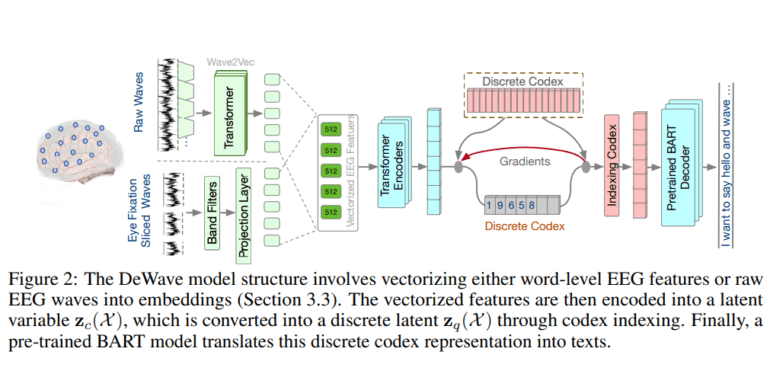TL;DR:
- GrapheneX-UTS unveils DeWave, an AI framework that translates thoughts to text.
- Potential applications in aiding speech-impaired individuals and enhancing human-machine interaction.
- Presented at NeurIPS conference as a non-invasive system.
- EEG data was captured with specialized caps and processed by DeWave.
- The significance lies in the direct conversion of EEG waves into language.
- Outperforms invasive procedures, promising adaptability for everyday use.
- Current translation accuracy stands at 40%, with plans for improvement.
- Research builds upon prior brain-computer interface advancements.
- Offers hope for effortless thought-to-word translation, revolutionizing communication.
Main AI News:
In a groundbreaking development, the Human-centric Artificial Intelligence Centre at GrapheneX-UTS (University of Technology Sydney) has unveiled DeWave, a pioneering AI framework designed to decode silent thoughts and transmute them into written text. This remarkable technology promises to revolutionize communication for individuals grappling with speech impediments caused by conditions such as stroke or paralysis while also ushering in a new era of human-machine interaction.
Presented as a spotlight paper at the prestigious NeurIPS conference in New Orleans, the research team introduced a portable and non-invasive system that represents a paradigm shift in brain-computer interfaces. Collaborating with experts from the UTS Faculty of Engineering and IT, the GrapheneX-UTS HAI Centre has crafted a method that translates brain signals into textual content without the need for intrusive procedures.
During the comprehensive study, participants silently perused text passages while donning a specialized cap equipped with electrodes designed to capture electrical brain activity via an electroencephalogram (EEG). This trove of EEG data underwent meticulous processing by DeWave, an AI model meticulously developed by the research team, which proficiently translates these intricate brain signals into coherent words and sentences.
One of the key highlights of this innovation is its ability to convert raw EEG waves directly into language, seamlessly integrating discrete encoding techniques into the brain-to-text translation process. This approach has opened up an array of possibilities in the realms of neuroscience and artificial intelligence.
Notably, unlike previous technologies that necessitated invasive procedures such as brain implants or the use of MRI machines, the team’s system offers a non-intrusive and practical alternative. An important distinction lies in the fact that it does not rely on eye-tracking, rendering it potentially more versatile for everyday use.
The study, conducted with the participation of 29 subjects, underscores the system’s robustness and adaptability, distinguishing it from past research, which was often confined to one or two individuals. Despite the inherent noise introduced by using a cap to collect EEG signals, the study yielded exceptional performance in EEG translation, surpassing previous benchmarks.
While the model excels in matching verbs, it exhibits a proclivity towards synonymous pairs when deciphering nouns. Researchers attribute this phenomenon to the similarity in brain wave patterns evoked by semantically related words during word processing.
As it stands, the current translation accuracy, quantified by the BLEU-1 score, hovers around 40%. The research team aspires to elevate this score to levels on par with traditional language translation or speech recognition programs, which routinely achieve accuracy rates nearing 90%.
This research represents a monumental stride forward, building upon the foundation of previous advancements in brain-computer interface technology at UTS. It holds tremendous promise for reshaping communication avenues for individuals who have long grappled with physical limitations.
The findings of this study offer a glimmer of hope in the quest to effortlessly translate thoughts into words, empowering those confronted by communication barriers and fostering enriched human-machine interactions.
Conclusion:
DeWave’s emergence in EEG-to-Text translation signifies a game-changing development in the market. With its non-invasive approach and potential to reach high translation accuracy levels, it opens up new opportunities for communication solutions and human-machine interfaces. Businesses should watch this technology closely as it could disrupt existing markets and create new ones in the field of assistive communication and AI-driven interfaces.

